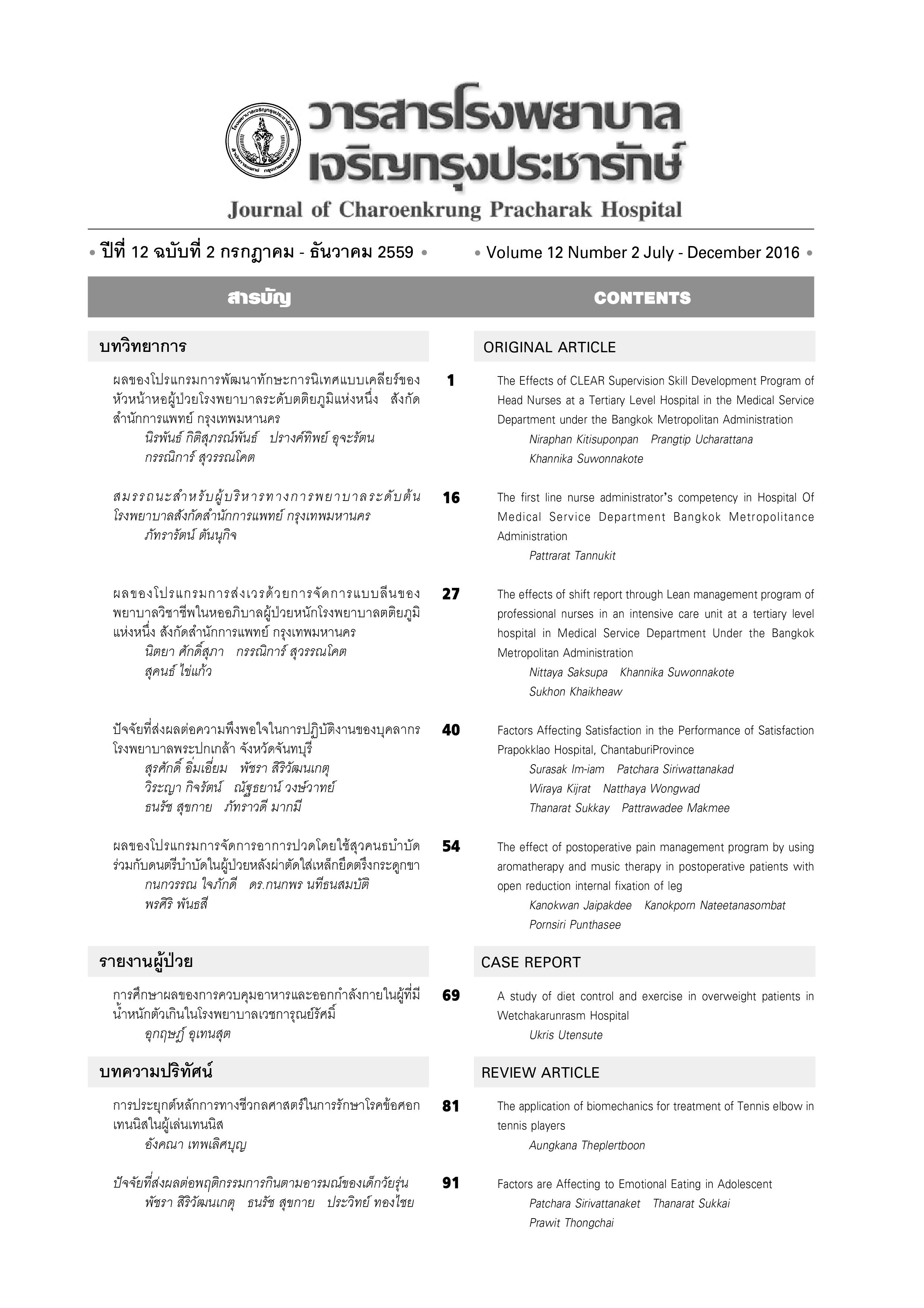การประยุกต์หลักการทางชีวกลศาสตร์ในการรักษาโรคข้อศอกเทนนิสในผู้เล่นเทนนิส
Main Article Content
บทคัดย่อ
บทนำ: โรคข้อศอกเทนนิสเป็นโรคพบบ่อยที่เกิดการบาดเจ็บจากการใช้งานมากเกินไปของเอ็นและกล้ามเนื้อกลุ่ม wrist extensor โดยเฉพาะ Extensor Carpi Radialis Brevis (ECRB) ผู้ป่วยมักมาด้วยอาการปวดเฉพาะที่บริเวณข้อศอกด้านนอกของแขนถนัด และพบว่า โรคนี้สัมพันธ์กับนักกีฬาหรือผู้ที่ประกอบอาชีพที่ต้องมีการกระดกข้อมือต้านแรงและหงาย ฝ่ามือซ้ำ ๆ ทำให้เกิดการบาดเจ็บแบบสะสม ความรู้พื้นฐานทางชีวกลศาสตร์ของแรง แรงกระทำ และการเคลื่อนไหวระหว่างการทำกิจกรรมจะช่วยให้เข้าใจกลไกการเกิดโรคข้อศอกเทนนิส ทั้งยังเป็นประโยชน์ช่วยในการรักษาและป้องกันการเกิดโรค
วัตถุประสงค์: เพื่อนำหลักการทางชีวกลศาสตร์ที่เกี่ยวข้องกับการเกิดโรคข้อศอกเทนนิสในผู้เล่นเทนนิสมาประยุกต์ใช้ในการป้องกัน รักษาและฟื้นฟู
วิธีการดำเนินการศึกษา: เป็นการทบทวนวรรณกรรม
ผลการศึกษา: มีปัจจัยเสี่ยงทางชีวกลศาสตร์ทั้งปัจจัยภายในและปัจจัยภายนอกที่เกี่ยวข้องกับการเกิดโรคข้อศอกเทนนิสในผู้เล่นเทนนิส เช่น อายุ กล้ามเนื้ออ่อนแรงหรือไม่สมดุล อุปกรณ์เครื่องมือกีฬาที่ไม่เหมาะสม จำนวนครั้งที่ทำซ้ำ ๆระหว่างการฝึกและการแข่งขัน และแรงกระทำต่อข้อที่มากเกิน การประยุกต์หลักการเพื่อใช้ในการรักษาและป้องกัน ทำได้โดยการฝึกออกกำลังกายแบบต้านแรงโดยเฉพาะแบบ eccentric exercise ซึ่งช่วยให้เกิดการปรับรูปในเนื้อเยื่อที่บาดเจ็บอย่างเหมาะสมและเพิ่มความแข็งแรงของความตึงตัวส่วนเอ็นกล้ามเนื้อทำให้เกิดการเชื่อมต่อแนวการเคลื่อนไหวที่ประสิทธิภาพ การยืดเอ็นกล้ามเนื้อช่วยเพิ่มความยืดหยุ่นของเอ็น การเพิ่มความก้าวหน้าในการฝึกอย่างเหมาะสม การฝึกการประสานงาน ประสาทการรับรู้ความรู้สึกบริเวณข้อต่อและการฝึกทักษะความชำนาญเฉพาะของแต่ละประเภทกีฬามีความสำคัญในการทำให้เกิดการเชื่อมโยงกลศาสตร์การเคลื่อนไหวที่ดี การเลือกไม้เทนนิสที่หน้าไม้ใหญ่ เอ็นขึงไม่ตึงเกินไป มีจำนวนเอ็นมากต่อหนึ่งหน่วยพื้นที่จะช่วยดูดซับแรงกระทำและลดแรงส่งผ่านมาที่แขน นอกจากนี้ยังมีการใช้อุปกรณ์รัดบริเวณแขนที่ระดับประมาณ 4 นิ้วต่ำกว่าข้อศอก ซึ่งจะช่วยลดแรงที่จะกระทำบริเวณรอยโรค
สรุป: การเล่นเทนนิสต้องอาศัยการเคลื่อนไหวและออกแรงอย่างเหมาะสมเพื่อให้เกิดการตีที่มีประสิทธิภาพ การส่งผ่านแรงที่ไม่ถูกต้องอาจทำให้เกิดการบาดเจ็บ การประยุกต์หลักการทางชีวกลศาสตร์ทำได้โดยการปรับเปลี่ยนปัจจัยเสี่ยงที่มีผลต่อแนวการเคลื่อนไหวที่เป็นสาเหตุของโรคเป็นประโยชน์ในการป้องกัน รักษา และฟื้นฟูโรคข้อศอกเทนนิสในนักกีฬาเทนนิส
คำสำคัญ: ชีวกลศาสตร์การกีฬา โรคข้อศอกเทนนิส
Article Details
เอกสารอ้างอิง
2. Tosti R, Jennings J, Sewards JM. Lateral epicondylitis of the elbow. Am J Med 2013;126:357.e1-6.
3. Masini BD, Dickens JF, Owens BD. Chapter 2 Tennis elbow in athletes: more than just tennis?. In: Wolf JM, editor. Tennis elbow clinical management. 2015. Available from http://www.springer.com/978-1-4899-7533-1.
4. Scott A, Bell S, VicenzinoB. Elbow and arm pain. In: Brunker P, Karim K, Bahr R, Blair S, Cook J, Crossley K, et al, editors. Brukner & Khan’s clinical sports medicine. 4thed. London: McGraw-Hill; 2012. p. 390-412.
5. Waseem M, Nuhmani, S, Ram CS, Sachin Y. Lateral epicondylitis: A review of the literature. J Back Musculoskelet Rehabil 2012;25:131-42.
6. Moore JS. Biomechanical models for the pathogenesis of specific distal upper extremity disorders. Am J Ind Med 2002;41:353-69.
7. Subbarao JV, Jayanthi N. Racket sports injuries. In: Buschbacher R, Prahlow N, Dave SJ, editors. Sports medicine and rehabilitation: A sport-specific approach. 2nd ed. PA: Lippincott Williams & Wilkins; 2009. p. 69-81.
8. de Smedt T, de Jong A, van Leemput W, van Lieven, D, van Glabbeek F. Lateral epicondylitis in tennis: update on Aetiology biomechanics and treatment. Br J Sports Med 2007;41:816-9.
9. Bartlett R, Bussey M, editors. Sports biomechanics reducing injury risk and improving performance. 2nded. New York: Routledge; 2012.
10. Martin C, Bideau B, Ropars M, Delamarche P, Kulpa R. Upper limb joint kinetic analysis during tennis serve: assessment of competitive level on efficiency and injury risks. Scand J Med Sci Sports 2014;24:700-7.
11. Eygendaal D, Rahussen FTG, Diercks RL. Biomechanics of the elbow joint in tennis players and relation to pathology. Br J Sports Med 2007;41:820-3.
12. Martin C, Bideau B, Bideau N, Nicolas G, Delamaeche P, Kulpa R. Energy flow analysis during the tennis serve: comparison between injured and noninjured tennis players. Am J Sports Med 2014;42:2751-60.
13. Bartlett R, editor. Introduction to sports biomechanics analyzing human movement patterns. 3rded. New York: Routledge; 2014.
14. Elliot B. Biomechanics and tennis. Br J Sports Med 2006;40:392-6.
15. Kibler WB. Clinical biomechanics of the elbow in tennis: implications for evaluation and diagnosis. Med Sci Sports Exerc 1994;26:1203-6.
16. Ellenbecker TS, Roetert EP, Kibler WB, Kovacs MS. Applied biomechanics of tennis. In: Magee DJ, Manske RC, Zachazewski, JE, Quillen WS, editors. Athletic and sport issues in musculoskeletal rehabilitation. China: Elsevier Saunders; 2011. p. 265-86.
17. Loftice J, Fleisig GS, Zheng N, Andrews JR. Biomechanics of the elbow in sports. Clin Sports Med 2004;23:519-30.
18. Bahr R. Principles of injury prevention. In: Brunker P, Karim K, Bahr R, Blair S, Cook J, Crossley K, et al, editors. Brukner & Khan’s clinical sports medicine. 4thed. London: McGraw-Hill; 2012. p. 113-37.
19. Rossi J, Vigouroux L, Barla C, Berton E. Potential effects of racket grip size on lateral epicondylalgy risks. Scand J Med Sci Sports 2014;24:e462-70.
20. Walther M, Kirschner S, Koenig A, Barthel T, Gohlke F. Biomechanical evaluation of braces used for the treatment of epicondylitis.
J Shoulder Elbow Surg 2002;11:265-70.


